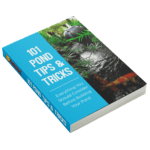#1 Get in your pond and vacuum out your pond gravel with an aquarium vacuum that you can buy at any pet store once per week. This will remove allot of the fish waste that would normally build up in the bottom of your pond and cause algae problems. Doing this will also change out about 1/4 water volume on your pond every week. If you can’t find an aquarium vacuum just make sure you do weekly 1/4 water changes with a pond pump. Also find yourself a rigid type of scrub brush to scrub down the rocks or the sides of your pond. This will also keep the algae growth to a minimum. This whole process only takes about 1/1/2 hours to complete once per week. Doing this weekly pond maintenance never allows the fish waste to build up in your pond thus, keeping your pond clean and not green.
#2 Keep the amount of fish in your pond to a minimum, the less fish you have in your pond the less waste you will have providing nutrition to algae growth. This will make it easier to keep your pond clean. Do not feed your fish more than once per day, this will keep the fish waste down to a minimum improving water quality. You should stock your pond with goldfish, shubunkins, comets, etc… They have a max size of only 12″ inches. Their smaller size makes it easier to keep a healthy water garden. Also thin out your baby fish in the spring when you do a full clean-out on your pond. The biggest problem with most customers’ ponds is that they have way too many fish you can have. Your pond filtration determines how many fish you can have, not the size of your pond. The average waterfall filter sold in the industry today is designed for a very small fish load. What I mean by small is 4 or 5 goldfish, shubunkins, or comets at a max size of 12″inches with no koi.
Koi get way to large for most backyard water gardens reaching an adult size of 36″ inches. It’s sad but allot of koi are forced to live out their lives in cramped under filtered ponds that stunt their growth, and lower their life span. Big fish also mean big waste; Koi can quickly turn a water garden into a green mess in record time. Koi require large ponds with perfect filtration to be at their best. We use large bead filters in conjunction with a waterfall filter when we build koi ponds. You also need to clean your waterfall filter once per month like an aquarium filter not once per year. This will also make your filter pads last allot longer than they would if you were cleaning them once per year.
#3 Remove all leaves, and spent lily and lotus blooms out of your water garden. They will rot and have to be broken down by bacteria. This will contribute to algae growth if they are not removed from your pond. Net your pond in the fall, and do a complete pond cleanout in the spring. Drain all of the water, power-wash the pond and stream, and clean out all filters.
#4 Plant your pond with lots of aquatic plants if you’re planning a water garden with minimal fish load shubunkins, comets, ect… up to 60% of your pond’s surface should be covered with pond plants. Plants provide shade and shelter for your fish which prevents algae growth, they also consume phosphorous the main nutrient in pond water that causes algae growth. Thus helping to keep your pond clean and not green.


